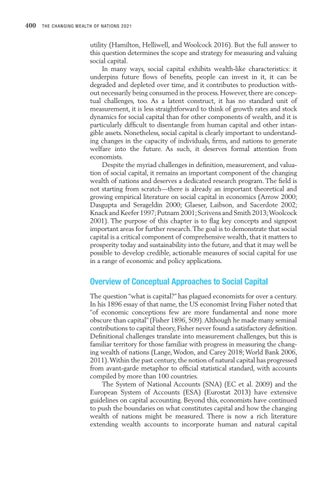400
T H E C H A N G I N G W E A LTH O F N ATIO N S 2021
utility (Hamilton, Helliwell, and Woolcock 2016). But the full answer to this question determines the scope and strategy for measuring and valuing social capital. In many ways, social capital exhibits wealth-like characteristics: it underpins future flows of benefits, people can invest in it, it can be degraded and depleted over time, and it contributes to production without necessarily being consumed in the process. However, there are conceptual challenges, too. As a latent construct, it has no standard unit of measurement, it is less straightforward to think of growth rates and stock dynamics for social capital than for other components of wealth, and it is particularly difficult to disentangle from human capital and other intangible assets. Nonetheless, social capital is clearly important to understanding changes in the capacity of individuals, firms, and nations to generate welfare into the future. As such, it deserves formal attention from economists. Despite the myriad challenges in definition, measurement, and valuation of social capital, it remains an important component of the changing wealth of nations and deserves a dedicated research program. The field is not starting from scratch—there is already an important theoretical and growing empirical literature on social capital in economics (Arrow 2000; Dasgupta and Serageldin 2000; Glaeser, Laibson, and Sacerdote 2002; Knack and Keefer 1997; Putnam 2001; Scrivens and Smith 2013; Woolcock 2001). The purpose of this chapter is to flag key concepts and signpost important areas for further research. The goal is to demonstrate that social capital is a critical component of comprehensive wealth, that it matters to prosperity today and sustainability into the future, and that it may well be possible to develop credible, actionable measures of social capital for use in a range of economic and policy applications.
Overview of Conceptual Approaches to Social Capital The question “what is capital?” has plagued economists for over a century. In his 1896 essay of that name, the US economist Irving Fisher noted that “of economic conceptions few are more fundamental and none more obscure than capital” (Fisher 1896, 509). Although he made many seminal contributions to capital theory, Fisher never found a satisfactory definition. Definitional challenges translate into measurement challenges, but this is familiar t erritory for those familiar with progress in measuring the changing wealth of nations (Lange, Wodon, and Carey 2018; World Bank 2006, 2011). Within the past c entury, the notion of natural capital has progressed from avant-garde metaphor to official statistical standard, with accounts compiled by more than 100 countries. The System of National Accounts (SNA) (EC et al. 2009) and the European System of Accounts (ESA) (Eurostat 2013) have extensive guidelines on capital accounting. Beyond this, economists have continued to push the boundaries on what constitutes capital and how the changing wealth of nations might be measured. There is now a rich literature extending wealth accounts to incorporate human and natural capital


